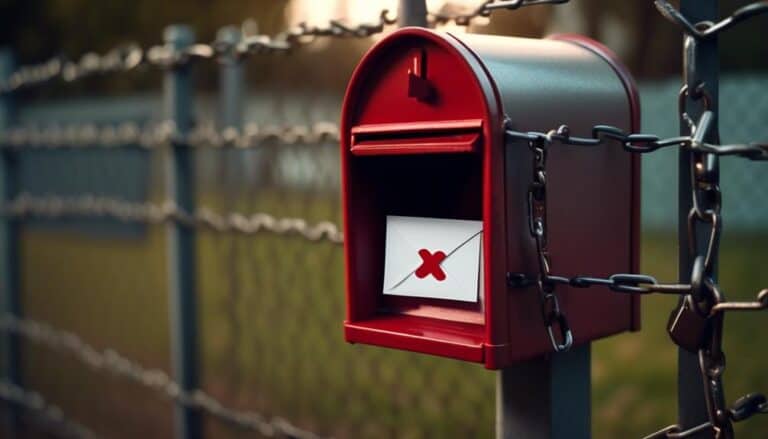Quick Guide to Efficiently Managing Unsubscribe Requests and Avoiding Spam Flags
Are you tired of receiving unwanted emails from companies even after you've clicked on the 'unsubscribe' button? Managing unsubscribe requests efficiently and avoiding spam flags is a crucial aspect of email marketing.
In this quick guide, we will explore the importance of prompt unsubscribe management, the impact of spam flags, and strategies to maintain a positive email reputation.
Whether you're a marketer or a business owner, understanding these key principles will help you streamline your unsubscribe process and ensure that your email campaigns are effective and compliant.
Stay tuned to discover the best practices and tools for managing unsubscribe requests and avoiding spam flags.
Key Takeaways
- Efficiently managing unsubscribe requests is crucial for compliance with anti-spam regulations and building trust with subscribers.
- Difficult unsubscribe processes can lead to spam complaints, so providing a prominent and easily accessible unsubscribe link or button is important.
- Promptly processing unsubscribe requests prevents further communication with unsubscribed individuals, decreasing spam complaints and improving sender reputation.
- Implementing authentication protocols like SPF, DKIM, and DMARC, along with regularly reviewing and updating the unsubscribe process, can enhance email deliverability and maintain compliance.
Importance of Unsubscribe Management

Managing unsubscribe requests is crucial for maintaining a compliant and reputable email marketing campaign. Efficiently managing unsubscribe requests not only ensures compliance with anti-spam regulations but also helps to build trust and credibility with your subscribers. By promptly honoring unsubscribe requests, you demonstrate respect for your audience's preferences and foster a positive user experience.
Unsubscribe efficiency is key in managing spam complaints. When subscribers find it difficult to unsubscribe from your emails, they may resort to marking your messages as spam. This can negatively impact your sender reputation and deliverability rates. To avoid this, make the unsubscribe process as simple and straightforward as possible. Provide a prominent unsubscribe link or button in your emails, and ensure that it's easy to locate and use.
Additionally, promptly process unsubscribe requests to prevent further communication with those who no longer wish to receive your emails.
Benefits of Promptly Handling Unsubscribe Requests
By promptly handling unsubscribe requests, you can significantly decrease the number of spam complaints received. This is crucial for maintaining a good sender reputation and avoiding potential penalties from email service providers.
Additionally, promptly honoring unsubscribe requests demonstrates respect for your customers' preferences and helps to build trust, leading to stronger customer relationships.
Decreased Spam Complaints
Promptly handling unsubscribe requests can lead to a significant decrease in spam complaints. When you promptly process unsubscribe requests, you show respect for your subscribers' preferences and minimize the likelihood of them flagging your emails as spam. This not only helps maintain a positive sender reputation but also enhances your email deliverability rates. By efficiently managing unsubscribe requests, you demonstrate a commitment to customer satisfaction and build trust with your audience. To further illustrate the benefits of handling unsubscribes promptly, consider the following table:
| Benefits of Promptly Handling Unsubscribe Requests |
|---|
| Decreased spam complaints |
| Improved sender reputation |
| Enhanced email deliverability rates |
Improved Sender Reputation
When you promptly handle unsubscribe requests, you can significantly enhance your sender reputation. Improved sender reputation leads to better email deliverability and increased chances of your emails reaching the recipients' inbox instead of being marked as spam.
Managing unsubscribe requests efficiently is a crucial aspect of sender reputation management. By promptly honoring unsubscribe requests, you show respect for your subscribers' preferences and demonstrate that you value their time and privacy. This builds trust and fosters a positive relationship with your audience. As a result, ISPs and email service providers view you as a responsible sender, improving your sender reputation.
With an improved sender reputation, your emails are less likely to be flagged as spam, ensuring that your messages have a higher chance of reaching the intended recipients and achieving the desired outcomes.
Enhanced Customer Trust
Handling unsubscribe requests promptly and efficiently enhances customer trust and strengthens your relationship with your audience. When you promptly handle unsubscribe requests, you show your customers that you respect their preferences and value their time. This builds customer loyalty and helps to establish a positive reputation for your brand.
By promptly removing unsubscribed individuals from your mailing list, you also avoid potential legal issues and maintain compliance with anti-spam laws. Furthermore, promptly handling unsubscribe requests allows you to focus your efforts on engaging with your active subscribers and building rapport with them. This can lead to increased customer satisfaction, higher open and click-through rates, and ultimately, improved business outcomes.
Understanding Spam Flags and Their Impact
To effectively manage unsubscribe requests and prevent spam flags, it's crucial to understand the impact of these flags and how they're assessed. Spam flags are indicators used by email providers to identify potentially unwanted emails and prevent them from reaching users' inboxes. Understanding how spam flags work can help you modify your email practices to ensure better deliverability and avoid having your emails marked as spam.
Here are four key points to consider:
- Spam flags definition: Spam flags are signals that email providers use to determine whether an email should be classified as spam. These flags can be triggered by various factors, such as the content of the email, the sending domain's reputation, or the engagement of the recipients.
- Understanding spam filters: Email providers employ spam filters to assess the likelihood of an email being spam. These filters analyze various elements, including subject lines, sender reputation, message content, and recipient behavior, to determine the email's spam score.
- Negative impact of spam flags: If your emails consistently trigger spam flags, they may not reach the intended recipients' inboxes. Instead, they could be diverted to the spam folder or blocked entirely. This can lead to decreased engagement, lower open rates, and damage to your sender reputation.
- Preventing spam flags: To avoid triggering spam flags, ensure that your emails are relevant, personalized, and sent to recipients who've explicitly opted in. Additionally, regularly monitor your email deliverability metrics and follow best practices for email marketing, such as avoiding excessive use of promotional language and including a clear unsubscribe option.
Strategies to Avoid Spam Flags in Email Campaigns

To ensure your email campaigns are delivered successfully to your subscribers' inboxes, you need to implement effective email deliverability strategies.
This involves following unsubscribe best practices, such as providing a clear and easy way for recipients to opt out of your emails.
Additionally, it's crucial to avoid triggering spam filters by carefully crafting your email content and avoiding common spam filter triggers.
Email Deliverability Strategies
Implementing effective email deliverability strategies is crucial for ensuring that your email campaigns aren't flagged as spam. To improve your email deliverability and avoid spam flags, consider the following strategies:
- Email Segmentation: Segmenting your email list based on demographics, interests, or engagement levels allows you to send targeted and relevant content to each group. This helps to increase open rates and engagement, which in turn improves deliverability.
- Email Compliance: It's important to adhere to email compliance regulations, such as the CAN-SPAM Act. This includes providing clear unsubscribe options, including your physical address, and honoring opt-out requests promptly. Staying compliant helps build trust with your subscribers and reduces the chances of your emails being marked as spam.
- Authentication and Authentication: Implementing authentication protocols like SPF, DKIM, and DMARC can help verify your domain and protect your reputation. These protocols prevent spammers from impersonating your domain and increase the chances of your emails reaching the inbox.
- Monitor and Analyze: Regularly monitor your email deliverability metrics, such as bounce rates, spam complaints, and engagement rates. Analyzing this data helps you identify potential issues and take corrective actions to maintain high deliverability rates.
Unsubscribe Best Practices
To ensure that your email campaigns aren't flagged as spam, it's essential to effectively manage unsubscribe requests and avoid spam flags. Implementing unsubscribe best practices will help you maintain a positive sender reputation and keep your subscribers engaged.
One important aspect to consider is monitoring your unsubscribe metrics. Keep track of your unsubscribe rates and analyze the reasons behind the opt-outs. This will provide valuable insights into the preferences and needs of your audience, allowing you to make necessary improvements to your email content and frequency.
Additionally, consider implementing unsubscribe automation. By providing a clear and easy-to-use unsubscribe process, you can ensure that subscribers who no longer wish to receive your emails can opt out without resorting to flagging your messages as spam. This won't only improve your deliverability but also enhance the overall subscriber experience.
Avoiding Spam Filter Triggers
To avoid triggering spam filters in your email campaigns, it's crucial to implement effective strategies that safeguard your messages' deliverability. Here are four strategies to help you avoid spam filter triggers and improve your email deliverability:
- Maintain a good sender reputation: Ensure that your email sending practices comply with industry standards and best practices. Monitor your sender reputation and address any issues promptly.
- Use a reputable email service provider: Choose an email service provider that has a good track record in email deliverability. They'll have the necessary tools and expertise to help you avoid spam filter triggers.
- Avoid spammy content: Craft your emails carefully to avoid using spam trigger words or phrases. Focus on providing valuable and relevant content that resonates with your audience.
- Test your emails: Before sending out your campaigns, test them with spam filters to identify any potential triggers. Make necessary adjustments to ensure your emails reach the inbox instead of the spam folder.
Best Practices for Unsubscribe Process Streamlining

Consider streamlining the unsubscribe process by implementing best practices.
Effective management of unsubscribe requests is crucial for maintaining email compliance and subscriber retention. By following these best practices, you can ensure a smooth and hassle-free unsubscribe process for your subscribers.
Firstly, make sure your unsubscribe link is easily accessible in your emails. It should be prominently displayed and clearly labeled, allowing subscribers to opt-out effortlessly. This not only improves the user experience but also helps you comply with email regulations.
Additionally, consider offering alternative options to unsubscribing. For example, you can provide a preference center where subscribers can choose the frequency or type of emails they receive. This allows them to tailor their email experience without completely opting out, increasing the chances of retaining them as subscribers.
Furthermore, streamline the unsubscribe process by using a one-click unsubscribe method. Avoid requiring subscribers to log in or provide additional information. Keep the process simple and efficient to avoid frustrating your subscribers.
Lastly, regularly review and update your unsubscribe process to ensure it remains compliant with current regulations and industry standards. By staying proactive and responsive to changes, you can maintain a positive relationship with your subscribers and minimize the risk of spam flags.
Maintaining a Positive Email Reputation
Maintaining a positive email reputation is crucial for ensuring deliverability and engagement with your subscribers. A good email reputation is built on several key factors that you need to be aware of and actively manage:
- Sender authentication: Implement email authentication protocols such as SPF, DKIM, and DMARC to verify your email's authenticity. This helps prevent your emails from being flagged as spam and improves deliverability.
- Engagement metrics: Monitor and analyze metrics like open rates, click-through rates, and spam complaints. High engagement indicates that your subscribers find value in your emails, which positively impacts your reputation and deliverability.
- List hygiene: Regularly clean your email list by removing inactive or disengaged subscribers. Sending emails to unresponsive recipients can negatively impact your deliverability and increase the chances of being marked as spam.
- Reputation monitoring: Keep a close eye on your email reputation by monitoring blacklists and email deliverability reports. Being aware of any issues or negative feedback allows you to take immediate action and maintain a positive reputation.
Tools and Resources for Effective Unsubscribe Management

As you focus on maintaining a positive email reputation, it is essential to equip yourself with the right tools and resources for effective unsubscribe management. By utilizing unsubscribe analytics and automation, you can streamline the process and ensure that unsubscribes are handled efficiently and in compliance with regulations.
Unsubscribe analytics provide valuable insights into the reasons behind unsubscribe requests. By tracking metrics such as open rates, click-through rates, and unsubscribe rates, you can identify patterns and make data-driven decisions to improve your email campaigns. Understanding the specific reasons why subscribers are opting out will help you tailor your content and reduce future unsubscribe rates.
Unsubscribe automation tools offer a convenient way to manage unsubscribe requests. These tools automate the process of removing unsubscribed contacts from your mailing list, ensuring that they no longer receive your emails. By automating this process, you can save time and effort while maintaining compliance with unsubscribe regulations.
Here is a table showcasing some popular tools and resources for effective unsubscribe management:
| Tool/Resource | Description |
|---|---|
| Unsubscribe Analytics | Provides insights into unsubscribe rates and reasons |
| Unsubscribe Automation | Automates the removal of unsubscribed contacts from mailing lists |
| Email Service Providers | Offer built-in unsubscribe management features |
| Compliance Guides | Provide information on legal requirements for managing unsubscribes |
Frequently Asked Questions
Can You Provide Examples of Specific Spam Flags That Email Providers Use to Determine if an Email Is Spam?
Spam flags, such as suspicious subject lines or excessive use of capitalization, are used by email providers to determine if an email is spam. Examples of these flags include "free," "urgent," and "viagra." It's important to avoid them to prevent your emails from being marked as spam.
How Can I Track and Analyze the Effectiveness of My Unsubscribe Process?
To track and analyze the effectiveness of your unsubscribe process, utilize various tracking methods and analyze metrics such as the number of unsubscribes, click-through rates, and open rates. This will provide valuable insights for improving your email campaigns.
Are There Any Legal Requirements or Regulations That Govern the Management of Unsubscribe Requests?
There are legal requirements and regulations that govern the management of unsubscribe requests. It is important to follow best practices to ensure compliance and avoid penalties.
What Are Some Common Mistakes or Pitfalls to Avoid When Handling Unsubscribe Requests?
When handling unsubscribe requests, it's crucial to avoid common mistakes and follow best practices. By doing so, you can efficiently manage these requests and prevent spam flags, ensuring a positive experience for both users and your organization.
How Can I Effectively Communicate With Subscribers Who Have Opted Out to Ensure a Positive User Experience?
To effectively communicate with subscribers who have opted out, respectfully acknowledge their decision and provide clear instructions for managing their opt-out preferences. This ensures a positive user experience and demonstrates your commitment to serving their needs.
Conclusion
In conclusion, efficiently managing unsubscribe requests and avoiding spam flags is crucial for maintaining a positive email reputation and ensuring the success of your email campaigns.
Promptly handling unsubscribe requests not only benefits your recipients but also helps build trust and credibility with your audience.
By understanding the impact of spam flags and implementing strategies to avoid them, you can streamline the unsubscribe process and improve the overall effectiveness of your email marketing efforts.
Utilizing tools and resources available can further enhance your unsubscribe management practices.








